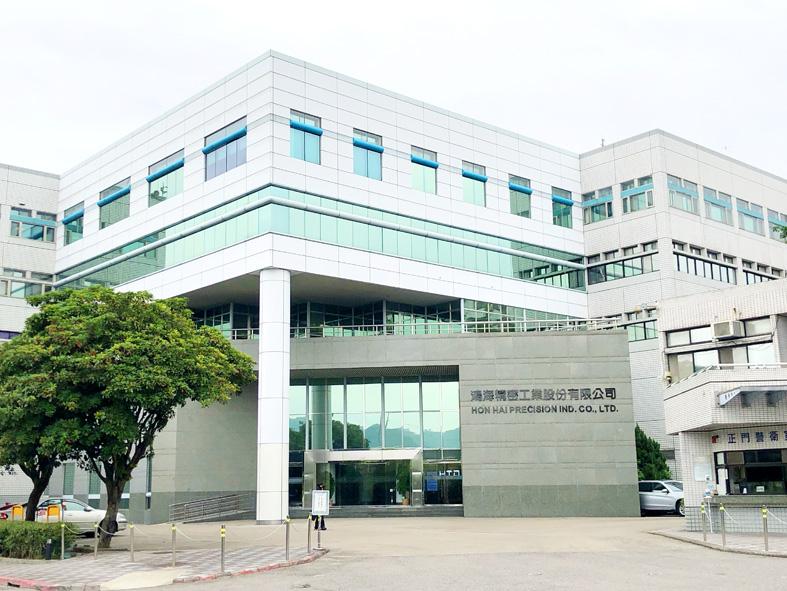Hon Hai Precision Industry Co (鴻海精密), which assembles Apple Inc’s iPads and iPhones, yesterday reported that its consolidated revenue last month was the highest in 11 months and had increased 12.86 percent from a month earlier.
Revenue was NT$621.71 billion (US$22.43 billion), up from NT$550.89 billion in October, the company said in a statement.
Last month’s results were in line with market expectations, as the company was gearing up to assemble new iPhone models and other electronics for the year-end shopping season.

Photo: Fang Wei-jie, Taipei Times
Hon Hai is a leading electronics manufacturing service company that primarily manufactures computer hardware, handsets and networking products for major global brands. It has four main business divisions: consumer and intelligent electronics, cloud and networking technology, computing products and components.
Compared with October, Hon Hai said it benefited from robust business at its components division, followed by its consumer and intelligent electronics division, its computing products division and then its cloud and networking businesses.
On an annual basis, revenue was down 8.76 percent, Hon Hai said, adding that its components division reported the highest sales growth, ahead of the cloud and networking, computing products and consumer and intelligent electronics divisions.
The company’s revenue for last month was the second highest on record for November, Hon Hai data showed.
For the first 11 months of the year, revenue totaled NT$5.28 trillion, up 13.67 percent from NT$4.64 trillion in the same period last year and the highest on record for the period.
Last week, Bloomberg News reported that Apple had told suppliers that demand for the iPhone 13 lineup had slowed, suggesting that interest among consumers for new iPhones is declining, which could affect the US company’s suppliers in Asia.
For Hon Hai, uncertainties from tight component supply and the COVID-19 pandemic to competition from Chinese peers would remain in the near term, analysts said.
While the company has been developing electric vehicle, robot and digital healthcare businesses as potential revenue drivers, their contributions would initially be limited because of low order visibility and Hon Hai’s huge sales scale, analysts said.

CHIP RACE: Three years of overbroad export controls drove foreign competitors to pursue their own AI chips, and ‘cost US taxpayers billions of dollars,’ Nvidia said China has figured out the US strategy for allowing it to buy Nvidia Corp’s H200s and is rejecting the artificial intelligence (AI) chip in favor of domestically developed semiconductors, White House AI adviser David Sacks said, citing news reports. US President Donald Trump on Monday said that he would allow shipments of Nvidia’s H200 chips to China, part of an administration effort backed by Sacks to challenge Chinese tech champions such as Huawei Technologies Co (華為) by bringing US competition to their home market. On Friday, Sacks signaled that he was uncertain about whether that approach would work. “They’re rejecting our chips,” Sacks

Taiwan’s long-term economic competitiveness will hinge not only on national champions like Taiwan Semiconductor Manufacturing Co. (TSMC, 台積電) but also on the widespread adoption of artificial intelligence (AI) and other emerging technologies, a US-based scholar has said. At a lecture in Taipei on Tuesday, Jeffrey Ding, assistant professor of political science at the George Washington University and author of "Technology and the Rise of Great Powers," argued that historical experience shows that general-purpose technologies (GPTs) — such as electricity, computers and now AI — shape long-term economic advantages through their diffusion across the broader economy. "What really matters is not who pioneers

BUBBLE? Only a handful of companies are seeing rapid revenue growth and higher valuations, and it is not enough to call the AI trend a transformation, an analyst said Artificial intelligence (AI) is entering a more challenging phase next year as companies move beyond experimentation and begin demanding clear financial returns from a technology that has delivered big gains to only a small group of early adopters, PricewaterhouseCoopers (PwC) Taiwan said yesterday. Most organizations have been able to justify AI investments through cost recovery or modest efficiency gains, but few have achieved meaningful revenue growth or long-term competitive advantage, the consultancy said in its 2026 AI Business Predictions report. This growing performance gap is forcing executives to reconsider how AI is deployed across their organizations, it said. “Many companies

China Vanke Co (萬科), China’s last major developer to have so far avoided default amid an unprecedented property crisis, has been left with little time to keep debt failure at bay after creditors spurned its proposal to push back a looming bond payment. Once China’s biggest homebuilder by sales, Vanke failed to obtain sufficient support for its plan to delay paying the 2 billion yuan (US$283.51 million) note due today, a filing to the National Association of Financial Market Institutional Investors showed late on Saturday. The proposal, along with two others on the ballot, would have allowed a one-year extension. All three